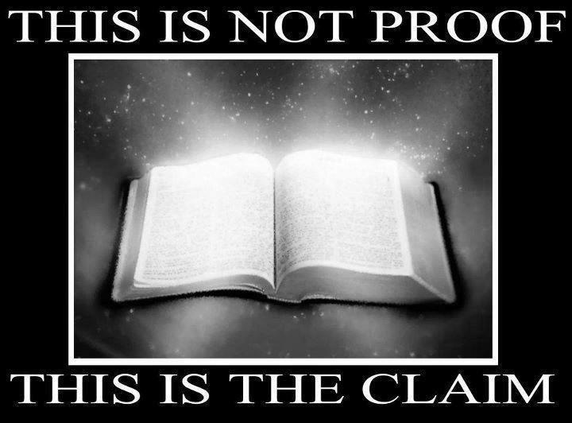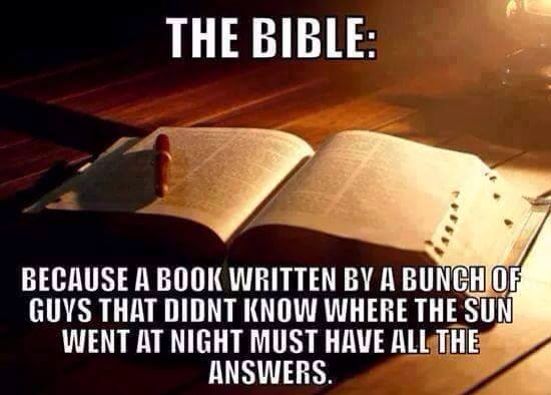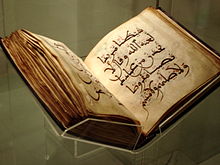“Why is the Bible called the Holy Bible?”
Christians believe their bible is holy because it was written by men under the direction and influence of the “Holy Spirit”.
“Just as God is perfect, so are His words perfect” (Psalm 19:7).
“Just as God is righteous and pure, so is His Word righteous and pure” (Psalm 19:8).
Christians believe their God literally breathed the words of Scripture into the writers of each of the books through supernatural means. The “divine” Writer is holy; therefore, what He writes is holy.
“All Scripture is God-breathed and is useful for teaching, rebuking, correcting and training in righteousness, so that the man of God may be thoroughly equipped for every good work” (2 Timothy 3:16).
Christians also believe their bible is the only book written by God Himself, the only book that has the power to set men free (John 8:32), to change their lives and make them wise (Psalm 19:7), to sanctify them and make them holy (John 17:17).
Christians believe their bible is the only book that gives life, comfort, and hope (Psalm 119:50), and it is the only book that will endure until the end of time (Matthew 5:18).
The bible itself is taken from the myth of many pagan gods as well as the gods and mythology of Egypt and the Mediterranean.
There is irrefutable, concrete evidence that the character of Jesus in the bible and the bible itself is taken from the myth of many pagan gods as well as the gods and mythology of Egypt and the Mediterranean. If you research gods like Mithra, Krishna, and just the idea of the “sun God/ son of God” you will be fascinated by how much was copied. They all share the same exact story of the savior, messiah, etc which was turned into the bible Jesus. However, these stories were written thousands of years before the bible. Mediterranean cultures in the ancient world shared standard ideas about gods and their powers and place in the universe and Christianity and the bible simply adopted those ideas and applied them to Jesus as is seen in the bible.
Heaven, hell, prophecy, demon possession, sacrifice, initiation by baptism, communion with God through a holy meal, the Holy Spirit, monotheism, immortality of the soul, and many other ideas of the bible all belonged to earlier, older Pagan faiths. They were simply part of ancient Mediterranean culture. Along with miracle working sons of god, born of a mortal woman, they were common elements of pre-Christian Pagan religion. Research Mithras, Dionysus, Attis, Osiris, Krishna, Orpheus.
Mithra who came before Jesus is described as ‘the Way,’ ‘the Truth,’ ‘the Light,’ ‘the Life,’ ‘the Word,’ ‘the Son of God,’ ‘the Good Shepherd.’ The idea of Jesus was taken from this. The Bible is not the inerrant word of God but a compilation of writings by men at this time. Mithras is often represented as carrying a lamb on his shoulders, just as Jesus is. The virgin mother, was easily merged with the virgin mother Mary. Petra, the sacred rock of Mithraism, became Peter, the foundation of the Christian Church.
The books that are in the Bible today were cherry picked. The book of Thomas and the book of the Gnostics were left out of the Bible on purpose by Constantine. They did not conform to the narrow interpretation of scripture that he wanted his subjects to follow. Because they tell us of a very different Jesus – one who had brothers and a wife and children.
The apocrypha, a selection of books which were published in the original 1611 King James Bible were positioned between the Old and New Testament (it also contained maps and geneologies). The apocrypha was a part of the KJV for 274 years until being removed in 1885 A.D. A portion of these books were called deuterocanonical books by some entities, such as the Catholic church.
What makes Christians think their religious text is the one that is right when there are thousands of other religious texts?
The following is an in-exhaustive list of other religious texts:
https://en.wikipedia.org/wiki/Religious_text
Adidam
- The writings of Franklin Albert Jones a.k.a. Adi Da Love-Ananda Samraj
- Aletheon
- The Companions of the True Dawn Horse
- The Dawn Horse Testament
- Gnosticon
- The Heart of the Adi Dam Revelation
- Not-Two IS Peace
- Pneumaton
- Transcendental Realism
Aetherius Society
- Contacts with the Gods from Space
Ásatrú
Atenism
Ayyavazhi
- The Akilathirattu Ammanai
- The Arul Nool
Aztec religion
- The Borgia Group codices
Bahá’í Faith
Books by Bahá’u’lláh
- The Four Valleys (1857 version)
- The Seven Valleys (1860 version)
- The Hidden Words of Bahá’u’lláh (in Arabic 1857)
- The Hidden Words of Bahá’u’lláh (in Persian 1857)
- Gems of Divine Mysteries (ca 1859)
- The Book of Certitude (partly in Persian and partly in Arabic 1861)
- Summons of the Lord of Hosts (ca 1868)
- Tabernacle of Unity (ca 1870)
- Kitáb-i-Aqdas (Completed 1873)
- Tablets of Bahá’u’lláh Revealed After the Kitáb-i-Aqdas (written until 1892)
- Epistle to the Son of the Wolf (ca 1890)
- Gleanings from the Writings of Bahá’u’lláh (compilation chosen by Shoghi Effendi of Bahá’u’lláh’s writings, 1853 to 1892)
Bön
Buddhism
- Theravada Buddhism
- The Tipitaka or Pāli Canon
- Vinaya Pitaka
- Sutta Pitaka
- Digha Nikaya, the “long” discourses.
- Majjhima Nikaya, the “middle-length” discourses.
- Samyutta Nikaya, the “connected” discourses.
- Anguttara Nikaya, the “numerical” discourses.
- Khuddaka Nikaya, the “minor collection”.
- Abhidhamma Pitaka
- East Asian Mahayana
- The Chinese Buddhist Mahayana sutras, including
- Diamond Sutra and the Heart Sutra
- Shurangama Sutra and its Shurangama Mantra
- Great Compassion Mantra
- Pure Land Buddhism
- Infinite Life Sutra
- Amitabha Sutra
- Contemplation Sutra
- other Pure Land Sutras
- Tiantai, Tendai, and Nichiren
- Shingon
Caodaism
- Kinh Thiên Đạo Và Thế Đạo (Prayers of the Heavenly and the Earthly Way)
- Pháp Chánh Truyền (The Religious Constitution of Caodaism)
- Tân Luật (The Canonical Codes)
- Thánh Ngôn Hiệp Tuyển (Compilation of Divine Messages)[13]
Cheondoism
- The Donghak Scripture
- The Songs of Yongdam
- The Sermons of Master Haeweol
- The Sermons of Revered Teacher Euiam[14]
Christianity
- The Bible (the Old Testament and the New Testament). Some denominations also include the Apocrypha.
- For Protestantism, this is the 66-book canon – the Jewish Tanakh of 24 books divided differently (into 39 books) and the universal 27-book New Testament. Some denominations also include the 15 books of the Apocrypha between the Old Testament and the New Testament, for a total of 81 books.
- For Catholicism, this includes seven deuterocanonical books in the Old Testament for a total of 73 books, called the Canon of Trent (in versions of the Latin Vulgate, 3 Esdras and 4 Esdras are included in an appendix, but considered non-canonical).
- For the Eastern Orthodox Church, this includes the anagignoskomena, which consist of the Catholic deuterocanon, plus 3 Maccabees, Psalm 151, the Prayer of Manasseh, and 3 Esdras. 4 Maccabees is considered to be canonical by the Georgian Orthodox Church.[15]
- The Ethiopian Orthodox Tewahedo Church (and its offspring, the Eritrean Orthodox Church) adds various additional books depending on the specific enumeration of the canon (see Ethiopian Biblical canon), but always includes 4 Esdras, the Book of Jubilees, 1 Enoch, 4 Baruch, and 1, 2, and 3 Meqabyan (no relation to the Books of Maccabees).
- Some Syriac churches accept the Letter of Baruch as scripture.
- The Bible
- Science and Health with Key to the Scriptures by Mary Baker Eddy. This textbook, along with the Bible, serves as the permanent “impersonal pastor” of the church.
- Nag Hammadi library and other Gnostic texts (not from the Bible)
- Some books of the Old Testament and New Testament
- Only the Gospel of Marcion and selected Pauline epistles accepted
(Image from the U.S. Library of Congress Rare Book and Special Collections Division.)
- The Bible (The New World Translation of the Holy Scriptures is their preferred translation.)
- The Bible
- The Church of Jesus Christ of Latter-day Saints (LDS Church) uses the LDS edition of the King James Bible for English-speaking members; other versions are used in non-English speaking countries.
- The Community of Christ (RLDS) uses the Joseph Smith Translation, which it calls the Inspired Version, as well as updated modern translations.
- The Book of Mormon
- The Pearl of Great Price
- The Doctrine and Covenants
- There are significant differences in content and section numbering between the Doctrine and Covenants used by the Community of Christ (RLDS) and the LDS Church.
- Other, smaller branches of Latter Day Saints include other scriptures, such as the Book of the Law of the Lord used by the Church of Jesus Christ of Latter Day Saints (Strangite) or The Word of the Lord used by Fettingite branches.
- Native American Church (Christian-leaning factions)
- See below.
- The Bible
- The writings of Ellen White are held to an elevated status, though not equal with the Bible, as she is considered to have been an inspired prophetess.
Confucianism
- The Five Classics
- The Four Books
- The Thirteen Classics
- The Three Commentaries
Discordianism
Druidism
- The Mabinogion
- Lebor Gabála Érenn (The Book of Invasions)
Druze
- Rasa’il al-hikmah (Epistles of Wisdom)
Ancient Egyptian religion
- Old Kingdom
- First Intermediate Period and Middle Kingdom
- Second Intermediate Period
Etruscan religion
Ancient Greece
Hermeticism
- Hermetica, Kybalion, Emerald Tablet and associated writings
Hinduism
- Itihāsas
- Mahābhārata (including the Bhagavad Gita)
- Ramayana
- Puranas (List)
- Tantras
- Sutras (List)
- Stotras
- Ashtavakra Gita
- Gherand Samhita
- Gita Govinda
- Hatha Yoga Pradipika
- Yoga Vasistha
- In Vedanta (Uttar Mimamsa)
- In Yoga
- In Samkhya
- Samkhya Sutras of Kapila
- In Nyaya
- Nyāya Sūtras of Gautama
- In Vaisheshika
- Vaisheshika Sutras of Kanada
- In Vaishnavism
- Vaikhanasa Samhitas
- Pancaratra Samhitas
- Divyaprabandam
- In Saktism
- Sakta Tantras
- 64 Bhairavagamas
- 28 Shaiva Agamas
- Shiva Sutras of Vasugupta
- Vijnana Bhairava Tantra
- Pashupata Sutras of Lakulish
- Panchartha-bhashya of Kaundinya (a commentary on the Pashupata Sutras)
- Ganakarika
- Ratnatika of Bhasarvajna
- Krishna-karnamrita
- Chaitanya Bhagavata
- Chaitanya Charitamrita
- Prema-bhakti-candrika
- Hari-bhakti-vilasa
- In Lingayatism
- Siddhanta Shikhamani
- Vachana sahitya
- Mantra Gopya
- Shoonya Sampadane
- 28 Agamas
- Karana Hasuge
- Basava purana
- In Kabir Panth
- poems of Kabir
- In Dadu Panth
- poems of Dadu
Islam
- The Quran (also referred to as Kuran, Koran, Qur’ān, Coran or al-Qur’ān) – Four books considered to be revealed and mentioned by name in the Qur’an are the Quran (revealed to Muhammad), Tawrat (revealed to Musa), the Zabur (revealed to Dawud) and the Injil (revealed to Isa)
- Hadith, reports of the deeds and sayings of Muhammad.
Jainism
- 11 Angas
- Secondary
- 12 Upangas, 4 Mula-sutras, 6 Cheda-sutras, 2 Culika-sutras, 10 Prakirnakas
- Secondary
- Karmaprabhrita, also called Satkhandagama
- Kashayaprabhrita
- Nonsectarian/Nonspecific
- Jina Vijaya
- Tattvartha Sutra
- GandhaHasti Mahabhashya (authoritative and oldest commentary on the Tattvartha Sutra)
Judaism
- Rabbinic Judaism
- See also: Rabbinic literature
- The Tanakh i.e. Hebrew Bible
- The Talmud
- Early texts:
- Noam Elimelech (Elimelech of Lizhensk)
- Kedushat Levi (Levi Yitzchok of Berditchev)
- Foundational texts of various Hasidic sects:
- Likutei Moharan (Breslov)
- Me’or Einayim (Chernobyl)
- Mei Hashiloach (Izhbitza – Radzin)
- Tanya (Chabad)
- Vayoel Moshe (Satmar)
- The Tanakh
- The Tanakh with several Jewish apocrypha
Konkokyo
- Konkokyo Kyōten (Sacred Scriptures of Konkokyo)
- Oshirase-Goto Obobe-Chō
- Konko Daijin Oboegaki
- Gorikai I
- Gorikai II
- Gorikai III[16]
Mandaeanism
- The Ginza Rba
- Book of the Zodiac
- Qolusta, Canonical Prayerbook
- Book of John the Baptizer
- Diwan Abatur, Purgatories
- 1012 Questions
- Coronation of Shislam Rba
- Baptism of Hibil Ziwa
- Haran Gawaita
Manichaeism
- The Evangelion (Greek: Εὐαγγέλιον, meaning roughly “good news”). Also known as the Gospel of Mani and The Living Gospel
- the Treasure of Life
- the Pragmateia (Greek: πραγματεία)
- the Book of Mysteries
- The Book of Giants
- the Epistles
- the Psalms and Prayers. A Coptic Manichaean Psalter, discovered in Egypt in the early 1900s, was edited and published by Charles Allberry from Manichaean manuscripts in the Chester Beatty collection and in the Berlin Academy, 1938–9.
- The Shabuhragan
- The Arzhang
- The Kephalaia (Greek: Κεφάλαια), “Discourses”, found in Coptic translation.
Maya religion
- The Popol Vuh
- the Dresden Codex
- the Madrid Codex
- the Paris Codex
- countless destroyed codices
Meher Baba
Native American Church
- The Bible (among Christian-leaning factions only)
New Age religions
Various New Age religions may regard any of the following texts as inspired:
Orphism
Raëlism
- The writings of Raël aka Claude Vorilhon
- Intelligent Design: Message from the Designers
- Sensual Meditation
- Yes to Human Cloning
Rastafari movement
- The Bible (Ethiopian Orthodox canon)
- the Holy Piby
- the Kebra Nagast
- The speeches and writings of Haile Selassie I (including his autobiography My Life and Ethiopia’s Progress)
- Royal Parchment Scroll of Black Supremacy
Ravidassia
Samaritanism
- The Samaritan Torah
Satanism
Science of Mind
- The Science of Mind by Ernest Holmes
Scientology
Shinto
- The Kojiki
- The Rikkokushi, which includes the Nihon Shoki and the Shoku Nihongi
- The Fudoki
- The Jinnō Shōtōki
- The Kujiki
Sikhism
- The Guru Granth Sahib
- The Dasam Granth
Spiritism
- The Spirits Book
- The Book on Mediums
- The Gospel According to Spiritism
- Heaven and Hell
- The Genesis According to Spiritism
Sumerian
- The Barton Cylinder
Swedenborgianism
- The Bible (several books omitted)
- The works of Emanuel Swedenborg (not considered equal to the Bible)
- The General Church
- The Bible (several books omitted)
- The works of Emanuel Swedenborg (considered equal to the Bible)
Taoism
Tenrikyo
- The Ofudesaki
- The Mikagura-uta
- The Osashizu
Thelema
- The Holy Books of Thelema, especially The Book of the Law
Unarius Academy of Science
- The Voice of Venus
Unification Church
- The Divine Principle
- The Bible as illuminated by more recent revelation
Urantianism
Wicca
Yârsân
Yazidi
- Yazidi Black Book
- Yazidi Book of Revelation
- The true core texts of the Yazidi religion that exist today are the hymns, known as qawls.
Yorùbá
Zoroastrianism
- Primary religious texts, that is, the Avesta collection:
- The Yasna, the primary liturgical collection, includes the Gathas.
- The Visperad, a collection of supplements to the Yasna.
- The Yashts, hymns in honor of the divinities.
- The Vendidad, describes the various forms of evil spirits and ways to confound them.
- shorter texts and prayers, the Yashts the five Nyaishes (“worship, praise”), the Sirozeh and the Afringans (blessings).
- There are some 60 secondary religious texts, none of which are considered scripture. The most important of these are:
- The Denkard (middle Persian, ‘Acts of Religion’),
- The Bundahishn, (middle Persian, ‘Primordial Creation’)
- The Menog-i Khrad, (middle Persian, ‘Spirit of Wisdom’)
- The Arda Viraf Namak (middle Persian, ‘The Book of Arda Viraf’)
- The Sad-dar (modern Persian, ‘Hundred Doors’, or ‘Hundred Chapters’)
- The Rivayats, 15th-18th century correspondence on religious issues
- For general use by the laity:
- The Zend (lit. commentaries), various commentaries on and translations of the Avesta.
- The Khordeh Avesta, Zoroastrian prayer book for lay people from the Avesta.















